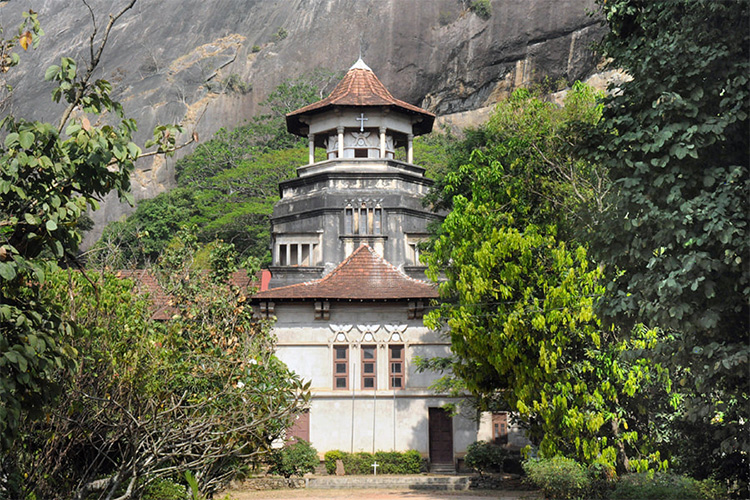OPINION

Cathedral of Christ the King (Photo by Uthpala Wijesuriya)
Culture is one of the stronger factors which could act either as a binding fabric or destructively as a sundering sword. It is the people, politics, religions, economics and demographics which would decide whether culture would bring forth its unifying character or dividing force. One could see both these phenomena in operation in several parts of the world.
In mixed cultures which had been in existence for long periods, as in Sri Lanka, there is unavoidable merging, assimilation and adoption of cultural elements of one community by the others. This is desirable and almost evolutionary in nature, and leads to the development of harmony and cordial relations between communities. Thus, a mainstream culture develops which looks upon benevolently on the subcultures, and in fact would be the driving force of the whole nation.
In Sri Lanka Buddhism, as Malcolm Cardinal Ranjith says, had been the backbone of the nation and therefore is the main cultural force. Yet Buddhists have adopted several desirable features from other cultures that they had come into contact with for long periods, for instance in the sphere of literature, music, etc. art, science, dress, food, customs, rituals, etc. Other cultures also have borrowed from Buddhism. An important and a significant feature that other cultures have borrowed from Buddhism is the essence of its attitude to life. Buddhism teaches a non-grasping attitude to life and material things, which actually has pervaded the Asian culture, not due to Buddhism alone but also Hinduism, Taoism, and Confucianism. This characteristic is elucidated by people like the American Psycho-sociologist Erich Fromm in his famous work “To have or to be” (1976). Hence the world view of the mainstream culture in Sri Lanka is non-grasping in character and all the communities conform to this pattern in varying degree. Everybody has trodden this path, albeit with occasional hiccups. Racial or religious fundamentalism or bigotry cannot have a place in such a mainstream culture.
This happy situation has been reached because the religion of the majority, Buddhism, has over the years demonstrated immense religious tolerance.
The Buddha himself laid the foundation for the development of such an attitude. He always referred to other religious teachers as Kammavadino , meaning persons who uphold the moral life and those who preach that society must have a moral foundation.
The Buddha thus recognised the right for all religions to exist in different places at different times, and also at the same place at the same time. Even when disciples of other religious leaders wanted to join Buddha’s Sangha, he would advise them to continue to support their previous teachers with their material needs. He admonished his disciples to treat other religious teachers with kind words, kind deeds and kind thought.
Christians in Sri Lanka have adopted Sinhala Buddhist cultural features, symbols, motifs architecture, and arts and crafts which developed from the time Ven. Mahinda brought to Sri Lanka Buddhism and seeds of its culture. The Second Vatican Council (1962) recommended that the Church should everywhere become a native church integrated into indigenous cultures.
Inculturation has enabled the Church to transform from universal standards to local cultural variations. For instance, the architecture of St. Philip Neris Church in Kalutara in Colombo Archdiocese reminds us of the Paththirippuwa of the Temple of the Sacred Tooth Relic in Kandy. The Paththirippuwa is an octagonal pavilion and one of the three main structures which comprise the temple in the palace complex of the former kingdom of Kandy.
A pair of large lotus-shaped punkalasa and a highly ornate semicircular sandakada pahana (moonstone) at the entrance of St. Philip Neris Church recall the entrance of ancient Buddhist monastic buildings. The lotus is a symbol of spiritual awakening in Hinduism and Buddhism.The sandakada pahana, a Buddhist symbol, can be seen at the entrance to several churches and Christian institutions.
The architecture of the Cathedral of Christ the Living Saviour resembles that of a Buddhist temple, while Trinity College chapel in Kandy is a rediscovery of ancient Buddhist heritage. Holy Rosary Church in Badalgama in Colombo is another church reflecting Buddhist architecture. Cathedral of the Christ in Kurunegala has an entrance with motifs typical of a Buddhist temple. It has a pattirippuwa and also Anuradhapura and Polonnaruwa architecture.
Let me reproduce extracts from Uditha Devaprya’s article titled “Reflections on an April in Kurunegala” which make reference to this Cathedral and also Gale Bandara Devala, a Muslim place of worship visited by all religious communities (The Island, 28.04.2023) “What can we conclude from that? Places and sites like the Gale Bandara Devalaya may be anachronistic at one level. But at another, they are in line with an identity that Sri Lanka has pursued. Kurunegala remains distinctly Buddhist. Yet as I mentioned earlier, it exists well beyond the city. By anchoring itself here, the Church of Ceylon reinforced these qualities, and in doing so it contributed much to that identity Sri Lanka may yet realise: one based not on an exclusivist framing of culture and community, but instead on an all-encompassing, tolerant, and benign reading of race and religion”.
Nothing good could be achieved by extremism practised by Buddhist “bala senas”, Wahhabism or proselytising (un)Christian cultism.
N.A.de S. Amaratunga
